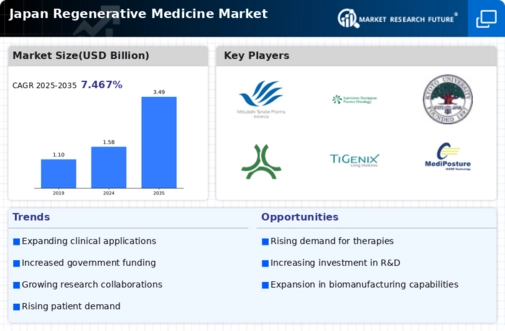Rising Incidence of Chronic Diseases
The increasing prevalence of chronic diseases in Japan is a significant driver for the regenerative medicine market. Conditions such as diabetes, cardiovascular diseases, and neurodegenerative disorders are on the rise, necessitating advanced treatment options. As of 2025, it is estimated that chronic diseases account for over 80% of healthcare expenditures in Japan, highlighting the urgent need for innovative therapies. Regenerative medicine offers potential solutions through cell therapies and tissue engineering, which aim to restore function and improve quality of life for patients. This growing demand for effective treatments is likely to propel investments in the regenerative medicine market, as healthcare providers seek to address the challenges posed by chronic illnesses.
Government Support and Funding Initiatives
Government initiatives significantly influence the regenerative medicine market in Japan. The Japanese government has implemented various funding programs aimed at supporting research and development in this field. For instance, the Ministry of Health, Labour and Welfare has allocated substantial budgets to promote regenerative medicine projects, which is expected to exceed $1 billion by 2026. Such financial backing encourages private sector investment and fosters collaboration between public and private entities. Additionally, regulatory frameworks have been streamlined to facilitate quicker approvals for innovative therapies, thereby enhancing the attractiveness of the regenerative medicine market. This supportive environment is likely to stimulate growth and innovation, positioning Japan as a leader in the regenerative medicine sector.
Collaborative Research and Development Efforts
Collaborative research initiatives among universities, research institutions, and private companies are vital for the advancement of the regenerative medicine market in Japan. These partnerships facilitate knowledge sharing and resource pooling, leading to accelerated innovation and development of new therapies. Notably, Japan has established several research consortia focused on regenerative medicine, which have attracted significant investment. As of 2025, collaborative projects are projected to account for over 30% of total research funding in the regenerative medicine sector. This collaborative approach not only enhances the quality of research but also fosters a competitive landscape, positioning Japan as a hub for regenerative medicine innovation.
Technological Innovations in Regenerative Medicine
Technological advancements play a pivotal role in shaping the regenerative medicine market. In Japan, innovations such as 3D bioprinting and stem cell therapies are gaining traction, enhancing treatment efficacy and patient outcomes. The integration of artificial intelligence in research and development processes is also noteworthy, as it streamlines the identification of potential therapies. As of 2025, the market is projected to reach approximately $5 billion, driven by these technological breakthroughs. Furthermore, collaborations between academic institutions and biotech firms are fostering an environment conducive to innovation, thereby propelling the regenerative medicine market forward. This synergy not only accelerates product development but also enhances the overall competitiveness of the industry in Japan.
Increased Awareness and Acceptance of Regenerative Therapies
Public awareness and acceptance of regenerative therapies are crucial for the growth of the regenerative medicine market in Japan. Educational campaigns and outreach programs have been instrumental in informing patients and healthcare professionals about the benefits and potential of regenerative treatments. As awareness increases, more patients are likely to seek out these innovative therapies, thereby driving market demand. Surveys indicate that approximately 70% of the population is open to exploring regenerative medicine options, reflecting a shift in perception towards these advanced treatments. This growing acceptance is expected to encourage healthcare providers to incorporate regenerative therapies into their practice, further expanding the regenerative medicine market.




















Leave a Comment